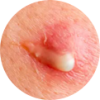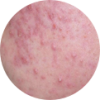Frequently asked questions
Will ingrown hairs go away?
If they’re not infected, ingrown hairs often go away on their own. If you are prone to ingrown hairs and your hair is suitable, we recommend laser hair removal.
How do you treat an infected ingrown hair?
We recommend that you speak to your doctor as they will have the best options for treatment.
Can you pop an ingrown hair?
We don’t recommend it. Try not to touch it to avoid it getting infected, and let it heal on it’s own. If you have concerns, speak to your doctor.
How can I prevent ingrown hairs?
Preventing ingrown hair reduces the risk of infection. If you’ve been shaving or waxing, try the following:
Alternatively if you are prone to ingrown hairs, you can book a consultation for laser hair removal to see how treatment can help you.
How can I prevent ingrown hairs?
Preventing ingrown hairs is important as it can decrease your risk of related infections. When you are shaving or waxing, try the following tips.
Wash your skin first to help prevent bacteria from entering the skin and always remove hair in the direction of growth. When shaving, you should change your razor blades frequently. Use shaving gel and warm water to help soften the hair, and don’t shave too closely to your skin (leave a little stubble if possible). Always apply lotion to the area afterwards and exfoliate your skin often.
At sk:n, our best option to help prevet ingrown hair is laser hair removal.
Our laser specialists will recommend your best course of treatment.
Request a callback
One of our friendly sk:n advisors will call you to book your consultation.
- More than 450 consultants, doctors, nurses and medical practitioners
- Regulated by the Care Quality Commission, Health Inspectorate Wales and Health Improvement Scotland
- Partner of the NHS
- Rated excellent by our clients on Trustpilot
- Strict safety and care protocols


